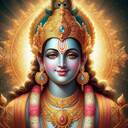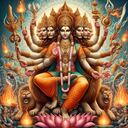Powerful Yantras are Dwellings of the gods. The principle behind this use of the yantra is basic to tantric perception. Each yantra makes visible the patterns of force that can be heard in the mantra sound syllable, and each yantra reciprocally encompasses its own unique power pattern.
Together, yantra-mantra may be said to build form, conserve form, and finally dissolve form.
Powerful Yantras: Meaning
The Sanskrit word 'yantra' derives from the root 'yam' meaning to sustain, hold or support the energy inherent in a particular element, object, or concept.
In its first meaning, yantra may refer to any kind of mechanical contrivance which is harnessed to aid an enterprise. A yantra in this sense, therefore, is any sort of machine or instrument such as is used in architecture, astronomy, and alchemy. chemistry, warfare, or recreation.
The meaning of the term yantra has been extended to refer to religious enterprises and has acquired a special theological significance. Mystic yantras are aids to and the chief instruments of a meditative discipline. Basically, a yantra used in this context and for this purpose is an abstract geometrical design intended as a 'tool for meditation and increased awareness.
How Powerful Yantras Works: Dwellings of the gods
Every yantra is a sacred enclosure, a dwelling or receptacle of Ishta-devatā (the chosen deity). A yantra is a substitute for an anthropomorphic image of the deity. Most Indian divinities, such as Krishna, Vishnu, Durgā, and Kāni, in addition to their iconographic representations, have been assigned aniconic symbols in their specific yantras.
A deity's yantra may bear no resemblance to the iconographic image (murti), whose proportions and human attributes are fixed by the traditional canon. A yantra retains the suprasensible vitality of an image, expressing the sense and spirit of the original.
Powerful Yantras: Principle
Every yantra builds a power field, a cosmic-sized circuit (kshetra) in which the powers of the sacred are invoked. The lines and planes localized within the yantra, though distinct from all the spaces that surround its outer circuit are an expression of a transcendental reality.
Stretching from star to star the ultimate substratum of all forms is space. Empty space is in itself a primordial substance and shares in the nature of divinity. Without it, the primordial substance whose abode is the whole universe would remain without support.
So the spaces within a yantra, however minute, can be symbolically brought to 'presence' and expressed as being as immense as the spaces within the solar system. Although in the abstract this is the immutable principle on which the space concept of yantras functions, on the level of human experience we are led to locating the sacred by creating spatial divisions.
The acts of bounding the figure. fencing its four quarters, defining its spatial orientations, and delimiting the sacred territory of the yantra, is an act of asserting where sacred space begins to manifest.
The yantras are energized in distinguishing tantric ways so as to acquire the maximum results from the mantra sadhana.
The Prana Pratishtha ceremony of Yantra
Just as the sadhaka is ritually transformed by the rites of initiation, so the yantra has to undergo a complete ritual transformation in order to be accessible for worship. One of the most important rituals of yantra worship is the infusing of vital force (prana) into the geometrical pattern of the yantra, called pranapratistha.
The objective is to cause the spiritual universe underlying myth and iconography to 'descend' into the yantra so that it becomes a radiant emblem and receptacle of cosmic power (shakti-rupa), and consciousness (Chaitanya), transforming into a sacred archetypal space that is phenomenally no more than a mere design.
The transfer of power from the sãdnaka to the yantra changes the nature of the diagram, and the consecration of profane space conversely elevates the sadhaka to realizing the inherent energy of the theophany, so that the yantra becomes a powerful means of contact between the sädhaka and the cosmos.
Another method of infusing vital force into the yantra is by the means of symbolic finger gestures (Avahana-mudra). The adept exhales his breath onto the appropriate finger positions to 'arrest' symbolically the essence of the divinity. He then slowly lets his closed hands descend onto the yantra.
In other ceremonies, the deity may be installed by uttering the tantric version of the famous Gayatri Mantra or variants of other well-known mantras. Some ritual manuals also outline a ceremony based on the ritual washing of the yantra with several liquids; in such a case the washing is symbolically suggestive of cleansing away impurities.
No matter what method the adept follows, the pranapratisthā ceremony affects a transformation of the yantra, which now begins to function on a different level of reality: it has become a receptacle of divine manifestations, the divinity in abstract form.
The yantra is 'transformed into a unit of archetypal space (ākāśa) which is identified with power (Sakti). No longer can the yantra be equated with gross matter veiling the spirit, but it has become instinct with the being of the deity with which it is aroused.
Yantra Puja
Then follows the external ritual of puja (adoration), or offering homage to the deity through the symbol of the yantra. Yantra puja is generally carried out daily, as an individual ceremony in which the adept establishes a link with the cosmic forces invoked in the yantra through the mystic groupings of devatās.
By means of an aesthetically pleasing ceremonial involving a variety of ritual ingredients - flowers. incense, water, food offerings, etc.- all of which have deep symbolism and involve his entire psycho-physical complex, the worshipper strives to achieve a state of bliss.
Who Can Energize the Yantra
The effectiveness of occult yantras depends upon the power of the guru, priest, or whoever performs the rites associated with them and their consecration. His power depends upon his knowledge of esoteric practices, his self-discipline (tapas), and his moral character.
The Yantrachintamani declares that the person who performs these rites must have faith, for if there is a loss of faith, the effect of the yantra will not merely diminish but will be the exact opposite of what is intended.
According to the Yantrachintamani, to consecrate such a yantra the officiant should, with a pure mind, draw the yantra in a lonely spot. He should then consecrate it with the appropriate mystic incantations for three days, during which he is to remain celibate and sleep on the ground.
The efficacy of the yantra can be gauged if during these three days he dreams: certain dreams are said to be premonitory of the accomplishment of the yantra's desired end.
Auspicious dreams that indicate the presence of power (siddhi) to procure the desired end are dreams of association with women, of enjoyment on a mountain-top or in a royal palace, of a procession of elephants, of the singing and dancing of women, of rejoicing in festivals. Some inauspicious signs are seeing black soldiers, a state of anarchy, peril from fire, air or water, the death of a friend."














